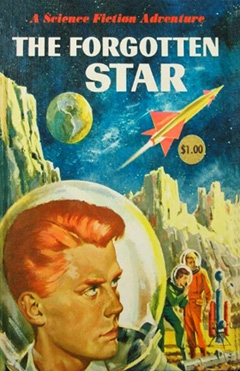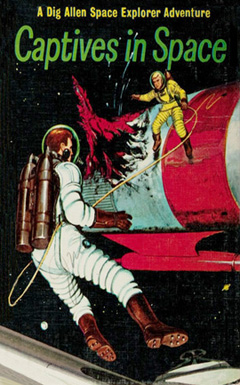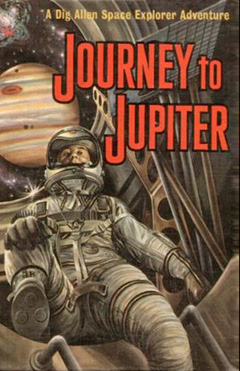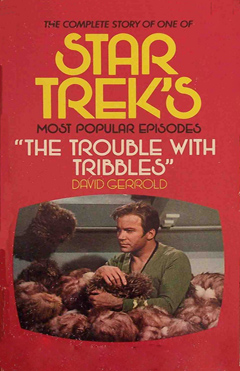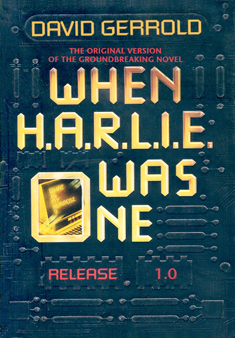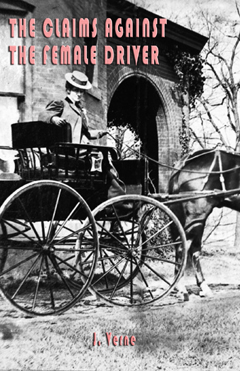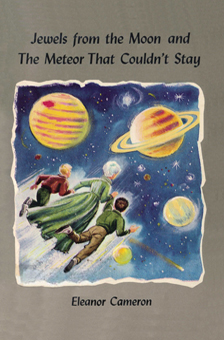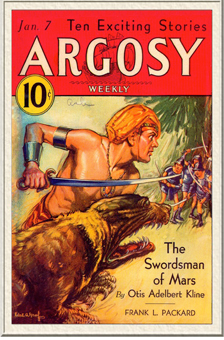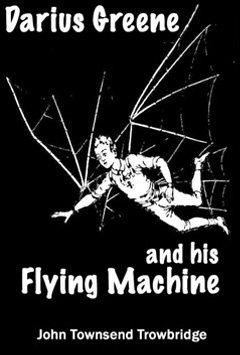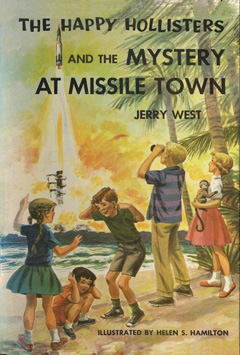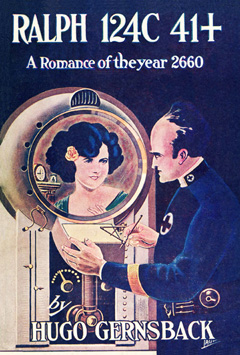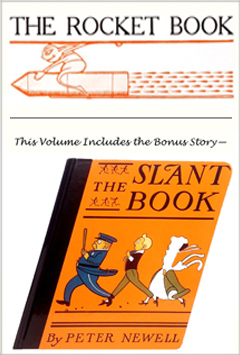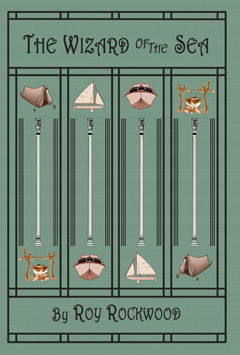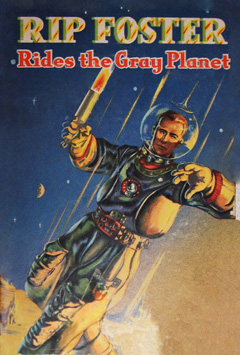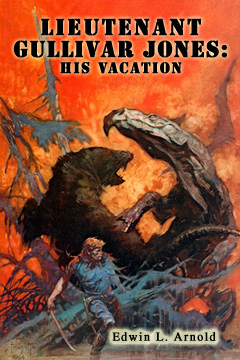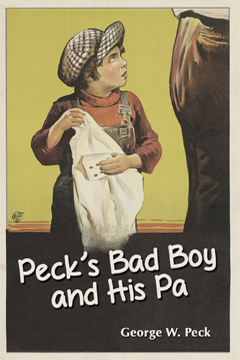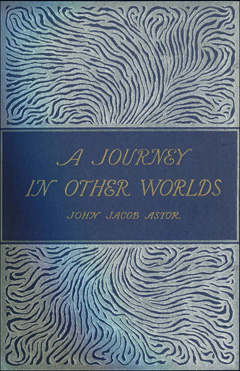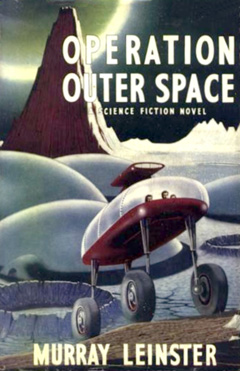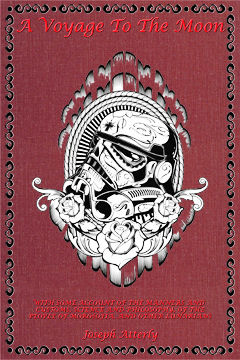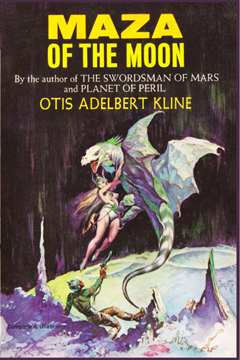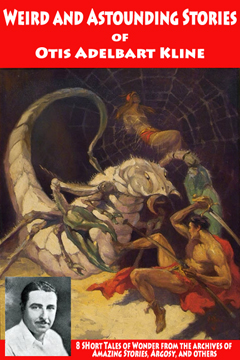The sources for the following stories come from personal scans of my three books and OCR-ings of books by Jon Cooper. The descriptions are from a website of Jon's.
Want to know more" See this set of informative pages.
The covers are from book scans and the Internet, and have been cleaned and fixed of cover tears, scratches and misaligned placement on scanners
(cut off edges or corners being the chief result).
(1959) Dig Allen and his two comapnions, Jim and Ken Barry, star in this short-lived series from the pen of Joseph Greene.
As the story opens, brothers Jim and Ken are traveling from Earth to a new city on the Moon. They discover a stowaway, young Dig Allen.
Dig has set out to find his father, a space scientist who mysteriously disappeared months before. The Barrys agree to help Dig. Their search takes them to the "Graveyard of Space" and to Mars where they meet Old Dorkas, the one person who is able to decipher the last message received from the missing man. The boys are forced to set out along in an unauthorized space ship and find themselves marooned on a weird, forgotten world at the outer edges of the solar system!
(1960) The three space explorers come upon an old, seemingly abandoned freighter with an unstable atomic reactor aboard. They find that the freighter still has a few passengers aboard. Through a smart scheme of their own the Explorers manage to save the freighter and find its 3 inch tall inhabitants.
After bringing the inhabitants to Eros and learn the creature's language using Boyd Allen's amazing computer that can translate any language and imprint it into the mind. The Space Explorers find that if the creatures are not returned to their planet soon they will die.
(1961) Dig and the brothers are sent to Ganymede, one of Jupiter's Moons, to investigate trouble at a colonization project. A desperate race begins against a gang of criminals--who plan to claim Ganymede's fabulous diamond deposits.
Once on Eros, they find out that the Langavac (a fabulous machine that can translate a language and embed it into anyone's mind) has translated enough records to enable the scientists to create a device called a nuclatomizer, a machine capable or taking matter apart and putting it back together as anything you want.
The plan to use these magnificent machines to create an artificial atmosphere in Ganymede might be more than anyone realizes!
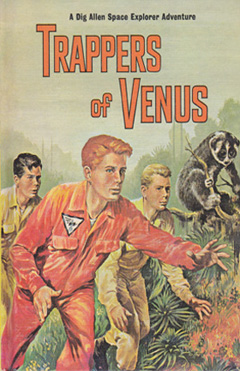
(1961) The swamps and wildlife of Venus are in trouble, and Tim Buckle comes to enlist the Space Explorers aid. Trouble arises, soon after Tim lands on Mars: a henchman throws him into the chilly Mars Canal--an act which means almost certain death to a man who has spent his life in the swamps of Venus. Dig tries to help him, but the dunking made Tim go insane: he and Dig blast off to Venus and leave Ken and Jim stranded.
The henchmen who tried to kill Tim take advantage of the situation and convince the other two Space Explorers that Dig has deserted them. Their only choice now, he convinces them, is to resign their commission as Space Explorers and throw their lot in with Linton Wells, a rich businessman.
Wells wants the two Explorers to certify the Venus Kohoolies as being non-intelligent so that he can begin killing them and exporting their skins.
Things take a sudden turn for the worse when Dig, Jim and Ken are caught by the Mist Flower and injected with the flower's fatal venom. Their only choice now is to journey to the intelligent Kohoolies' secret city to be treated by their doctors-- for the fate of all Venus rests upon them!
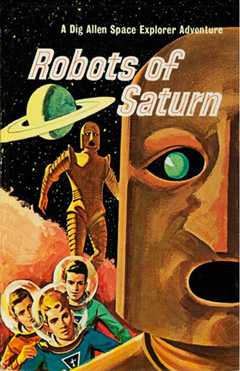
(1962) The three Explorers set out to mine the rings of Saturn! An expedition discovered that the rings are the only place in the Solar System where Methane-X can be found--and Methane-X is the key material Space Research needs in order to build an interstellar spaceship.
But mining the rings is too hazardous a task for human beings: the ice flowing in the Rings would kill any ordinary human being. The brilliant Professor Norwyn, however, has come up with a solution: the M-Roboots: fantastically powerful robot bodies.
Norwyn can transfer the consciousness of a human being into a robot. Once transferred, the person can see through the robot's eyes, move the robot's body, and has the robot's invulnerability, which is critical to carrying out any mining expeditions.
At first everything goes well and the Explorers are able to get a valuable cargo of the Methane-X gas. But soon things go awry: they start glimpsing other golden robots--robots which couldn't exist--and then the entire crew disappears. Soon Dig and Ken find themselves battling a horde of sentient, intelligent robots who seems bent on destroying them all!
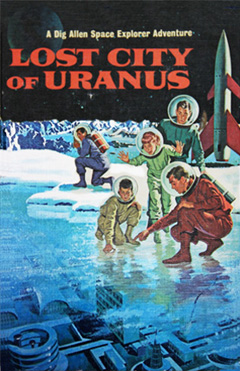
(1962) Repairmen on a ship orbiting Jupiter find a message in a bottle in space. The note was written by a man just before his ship was going to crash on Uranus, and said that he saw huge, wealthy cities on the planet below him.
Dig goes to Uranus to see if this could be from his missing father. There, deep under the frozen ice of that planet, he discovers what looks like a lost civilization under the huge sheets of "ice". After getting through a small hole in the ice he and his team find a people still living there in the unfrozen depths.
But, unthinking smugglers, once sent back to Earth, return and burn through the ice--which is actually a thick colony of living organisms capable of holding out the sub-zero cold--causing the organisms to start to die. Once enough of them are gone everything will start to freeze up. All they can see is untold wealth in the atrifacts of the civilization.
Even when they learn that they have doomed the inhabitants and must get out while they are able, the smugglers still will not leave behind their loot--and thus they were killed, along with the rest of the fantastic city, when the organisms they had killed finally died.
|
This is the complete story of how author David Gerrold came up with a concept which he finally sold to the producers of Star Trek, and everything that went into turning it into a shooting script, and how Fuzzie became Tribbles and a part of history!
|
David Garrold also wrote this one, the story of an AI who becomes self aware and how he and his creator kept him from being killed. |
|
The first of Aldous Huxley's published short stories from 1920. Includes the critically acclaimed, "Farcical History of Richard Greenow." He had previously published five books of poetry. Huxley had a more impish side to his writing before he told us about Big Brother and spawned the most memorable television advertisement of all times! The cover art is taken from an Italian paperback reprint.
|
A hitherto undiscovered short story by Monsieur J. Verne as he laments the state of the roads in his small French town of Amiens once the local Magistrate declares it is right and proper that females be given the chance to drive even the speediest of horse drawn carriages of the day. His complaints were decades ahead of their time. |
|
Jewels From The Moon and A rare gem from Eleanor Cameron. It is a companion piece to her Mushroom Planet books, originally published in limited quantities as a "reader" for school kids. While the cover art has not been difficult to locate, and some of the illustrations, until I reassembled this from several sources I had not seen it with everything including the in-class work that appears at the end of each of these two short stories. From a publishing standpoint, these stories came between A Mystery For Mr. Bass and Time and Mr. Bass but the book is not truly associated with the other novels. All the original, color illustrations are in this edition and it is a page-for-page complete reproduction. |
Going along with another Kline book (listed below) dealing with adventures on strange (non-Earth) worlds, this is from a series of stories Otis Adelbert Kline serialized in Argosy and a few other magazines of the day. And, like the works of E.R. Burroughs, it deals with a man finding himself on Mars having to face angry warriors, strange and deadly animals, and dealing with a Princess. It originally appeared in six parts published in Argosy in early 1933 and was followed by his seven-part The Outlaws of Mars later in that same year. Kline also wrote three novels in a short series dealing with adventures on Venus. |
Darius Greene and His Flying Machine Basically a poem celebrating one young boy's desire to build a flying machine, it was once so popular that the Wright Brothers Coompany built an add campaign suggesting that they had a better answer! A Wright Flyer. |
The Happy Hollisters... Missile Town The family that travels together, solves mysteries together. This time they go to Cape Canaveral where a valuable capsule from a failed rocket is missing. While trying to help find it, the kids stumble on some very shady characters! |
(1911) A romance set in the year 2660. Among the first science fiction stories to tackle the tricky balance of having an actual story that didn't involve wars in space, or invading aliens from space, this is a somewhat gentle telling of an unlikely romance in the day when people nop longer have names, just alpha-numeric designations. Ralph and Alice fall in love amid his experiments with reanimationof dead tissue (remind you of anything?). He has a process that can suspend death and deterioration and has used in on a dog. But, what can he do with the experimental process when Alice is kidnapped and killed by a wouldbe suitor? A good mix of story and well-though science fiction. Hugo Gernsback knew what he was doing. |
The Rocket Book & The Slant Book Between 1910 and 1912, Peter Newell wrote these two gems designed to engage small childred and their imagination. Both books are written in verse. In The Rocket Book, a rotten kid sneaks a firework rocket into the basement of a tall apartment building and sets it off. As it travels up floor-by-floor, illustrations show the effect it has on the inhabitants, plus a growing hole shows how much damage it is creating. The Slant Book was printed at a slant as you see above. Everything inside having to do with the story was also slanted. Enjoy these two relative unknowns, now under one cover. |
|
(1900) Oh, where to begin. Well, start with a huge dash of Jules Verne's 20,000 Leagues Under the Sea, and... Nope, that's about it. Really. Kidnapped trio of men, primative scuba gear, meglomaniac captain of strange sub... This is an unapologetic ripoff of that classic story right down to scenes of island savages trying to attack the submarine and getting electic shocks. But, it is not badly written and is worth the comparisson read. The cover is a recreation of the cloth cover from this book. Not certain why they put a speedboat, sailboat, campfire and tent. |
RIP Foster Rides the Gray Planet Possibly one of the few books to be published twice (1952, 1958) with different titles and completely different illustrations. Freshly graduated and commissioned Planeteer (space-going Marine) Lt. Richard Ingalls Peter ("Rip") Foster finds himself contending with inter-service rivalry with the Space Force (Navy) crewmen with whom he serves. He is tasked with retrieving an asteroid made of pure thorium from the asteroid belt and bringing it to Earth for use as fissionable material. His efforts are opposed by agents of the "Consolidation of Peoples Governments", who also seek control and use the asteroid. I've included both sets of illustrations in this edition. |
|
(1884) Edwin Abbotts classic mathematical fiction novella. Imagine a world without the third dimension of depth. Everythingis on a single plane; if viewed from the side, you see nothing. This was mandatory reading when I took Geometry back in high school, and then again in college for a course called "Alternative Thinking."
|
Lieutenant Gullivar Jones: His Vacation (1905) Although never achieving the success of Edgar Rice Burroughs' Mars stories, this predates them by decades and some scholars (or those who describe themselves as such) think Burroughs may have beeninfluenced by this story. It was republished with a more scientific title later on. The cover art is a Frazetta from a 1964 paperback printing. |
|
The story of how Japan came to attack the United States in an attempt to take it over, causing a terrible war to ensue. The thing is, this was written in 1908, pre-World War I and, like another book by German author Ferninand Heinrich Grautoff (under his pen name of Parabellum), it eerily fortells of events that happen in his future. That other book, The Collapse of the Old World (1905), tells of a Europe-wide war that ends in the reduction of the Third Reigh, The United Kingdom, and several other powerful nations being demoted to second-world nations. That pre-dated World War I by nearly a dozen years! |
Not just off topic, not anywhere close to science fiction! I include this because, like many, I grew up with grandparents who regaled me with stories from George Peck's strange world of a rather ill-behaved boy and his adventures with and without his father. Enjoy it for what it is (free, one of the fine attributes) and for historical value as it was published in 1883 and contains the original illstrations and book cover art (page 1 of the file). |
|
Most people believe John Jacob Astor was just a rich guy with a New York hotel named after him. Right and WRONG! While there was family money involved, Astor patented several inventions, including a bicycle brake in 1898, a "vibratory disintegrator" used to produce gas from peat moss, a pneumatic road-improver, and helped develop a turbine engine. He made millions in real estate. His A Journey in Other Worlds, is a 1894 science fiction novel about life in the year 2000 on the planets Saturn and Jupiter. It was written in three parts. This edition contains all the tex plus the original illustrations. |
Originally published in a limited edition (supposedly under 2,100 copies) this novel take the approach that in order to fund a space exploration program, the orgainizers need to make a space exploration program. Literally. A television show is developed to finance the world's first outer space trip to the Moon, and possibly beyond. It may not take a Verne-like look into the future (it was published in 1954 and is a bit off the mark compared to what actually happened) but it takes a good jab at PR people and the television industry while telling a fairly good space story. |
|
(1827) Predating H.G. Wells' First Men In The Moon by some 74 years, this tells the tale of an excentric inventor who coats a home-built space vessel in an antigravetic metal and soars up to the Moon where he and his companion find some strange and mysterious creatures and a place of wild winds, odd vegetation and intriguing animals. If there are parallels to be drawn, pull out your copy of the Wells' story, get out your crayons and start sketching! |
(1909) A true visionary, astronomer and author Serviss wrote about a man who becomes the first to harness "inter-atomic energy" to power a spaceship. His discovery enables him to navigate the Ocean of Ether and sail to the shores of another world. He constructs a curious spool-shaped space vehicle and "sets sail" into space, arriving with his companions on the planet Venus. |
|
Otis Kline was an author and journalist who wrote about fantastic civilizations on Mars, Venus, the Moon, and other places. His work had swordsmen, princesses and hairy ape-like beasts. And, no. He was not Edgar Rice Burroughts, although the two did seem to have a little one-upsmanship thing going on. Maza is a stand-alone novel about what was supposed to be a observation trip to the Galapagos Islands that ends up with the hero on the Moon in an attempt to halt a number of projectiles that have been destroying Earth cities. Maza is, by the way, a female ruler on the Moon. |
Revenge of the Robot and Other Short(ish) Stories This is not an official book; it is a collection of my various short stories by Otis Kline with cover art from their initial publications and some line art created for such pulp magazines as Astounding Stories. This collection features 7 of his shorts plus an essay he published in The WRiter magazine describing what it takes to "write a fantastic story." |
